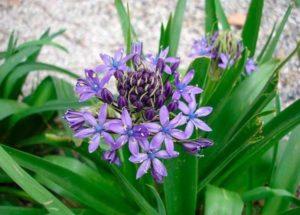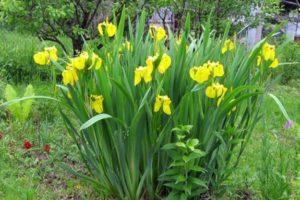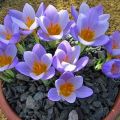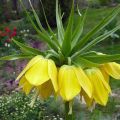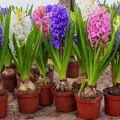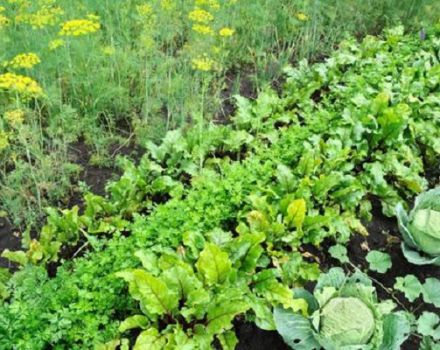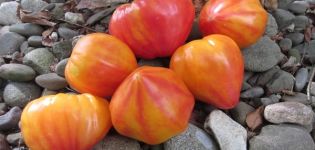How to grow crocuses at home, planting and care in a pot
Crocus or saffron is a perennial bulbous plant whose flowers resemble small tulips. There are many varieties of crocuses that differ in color and when they bloom. Some bloom in early spring, others in winter, so this plant can decorate the house even for New Year's holidays. But planting crocuses at home and further caring for them differ in their specificity. It is also important to choose the right variety.
The best varieties of crocuses for home
It is best to choose Dutch varieties for planting at home. Among them, note the following:
- Prince Claus is a white flower with purple "brush strokes", a feature of a strong and pleasant scent. Flowering time - March-early April, under good conditions can bloom even in February.
- Blue Pearl - fully justifies its name, which means "blue pearl". Flowers of an azure shade, yellow at the base, grow up to 8 centimeters. Blooms in early April.
- Jeanne d'Arc - the petals of this variety are large, white, which turns into lilac below. Dissolves by mid-April.
- Flower Record - the stem of this variety is small, but the flowers are large in size, the color is deep purple, it becomes darker towards the bottom. Flowering time is the end of April.
- Cream beauty - large golden flowers, stamens - yellowish orange. Blooms from early May.
It is not necessary to be limited to one variety. A combination of several will look more beautiful, then a whole kaleidoscope of crocuses on the windowsill will delight you.
What conditions are needed for a plant
Crocuses cannot be called whimsical plants, the main thing is that the following conditions are met:
- Low temperature - up to 20 degrees, in winter even up to 10.
- Adequate lighting.
- You need to water a little, but regularly.
- Soil drainage.
After distillation, the plants must be left until the leaves are completely dry, but watering cannot be stopped. Then the bulbs are stored.
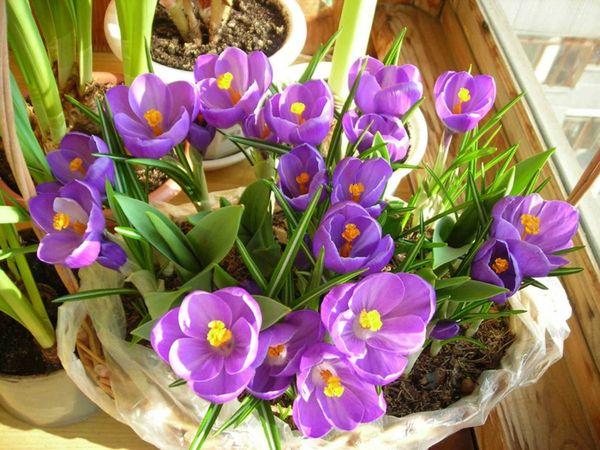
Soil composition and pot volume and drainage
To choose the right pot, first determine how many bulbs you want to plant. Usually it is 5-10 pieces. The main thing is not to allow the bulbs to touch each other or the walls, so choose a low and wide pot. You can buy pots designed for forcing bulbs at a flower shop.
The following requirements are imposed on the soil for crocuses - neutrality, lightness and the presence of drainage. You can take a flower substrate or prepare a mixture of the following components, taken in equal parts, on your own:
- coarse sand;
- turf mixture;
- leaf mixture.
Another option is a thick layer of sand at the bottom, then the soil, however, it is used only if later you plan to use the crocus for reproduction. For drainage, gravel, pieces of bricks, and tiles are sometimes also used. The pot itself must be placed on a pallet where water will flow.
Choosing a place
On the one hand, these plants love light, so the south side of the house is best for them. But at the same time, the temperature regime is also important. The ideal place is on the balcony. There, during the spring months, the necessary coolness remains, and by the time of flowering, in March-April, the air warms up to 16-20 degrees.
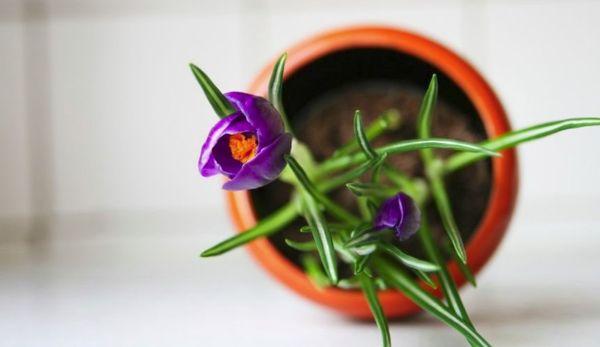
Lighting
Lighting depends on what stage of growth the plant is in. If you have just planted crocuses, then you need to hold them in a dark place until the sprout grows up to 5 centimeters and becomes strong. Then you need to rearrange the plants in a well-lit place where they will be under the sun for at least 4 hours a day. Move them back to the shade during flowering to keep the flowers open longer.
Temperature regime
Crocuses that are about to bloom or have already bloomed should be in the coolest place in the house. The ideal temperature is + 14-16 degrees. At +20 and above, the plants bloom for a very short time, and after a few hours they can shed their petals. Even frosts down to -3 are permissible at night.

Humidity
Crocuses are drought tolerant, so they do not need abundant watering. But drainage is very important, otherwise the bulbs will rot. Under no circumstances should water stagnate in the ground. Spraying of plants is acceptable, but also infrequently and little by little.
Resting state
The crocus falls into a dormant state after all the leaves are dry. This period falls in the summer months. It is important to store the bulbs correctly by placing them in a cool, dark and dry place. Watering during this time is not required to prevent the bulbs from rotting.
Features of planting bulbous culture
In order for the crocus to bloom, you need to know how to plant it correctly. Planting takes place in several stages, the first of which is the selection of bulbs.

The choice of planting material
Both condition and size are important when choosing bulbs. The health of plants and the splendor of their flowering depend on them. Consider each carefully:
- Refrain from buying planting material if rot, spots, any damage are visible.
- If, after purchasing, you still notice that there are defects, carefully cut out this part of the bulb, and disinfect the damaged areas with ash or coal.
- The bulbs need to be dried well before planting (store-bought crocuses are usually already treated with this treatment).
- Prepared crocuses should be free from scales, soil and root debris.
- The number of flowers that a bulb will give and the time of their flowering directly depend on its size. Small bulbs often produce only one flower, which quickly falls off.
Botanical varieties of crocuses are not suitable, that is, taken from flower beds - their buds are small and quickly fade.
Cooling
After purchasing, the bulbs are cooled. The temperature drop takes place in two stages:
- Within 7-10 days, the temperature should be about +20 degrees, then - 17.
- For another 20-30 days, you need to keep it wrapped in thick paper in the refrigerator or frost-free cellar. Temperature - from +3 to +9.
The plants are then ready to be potted.
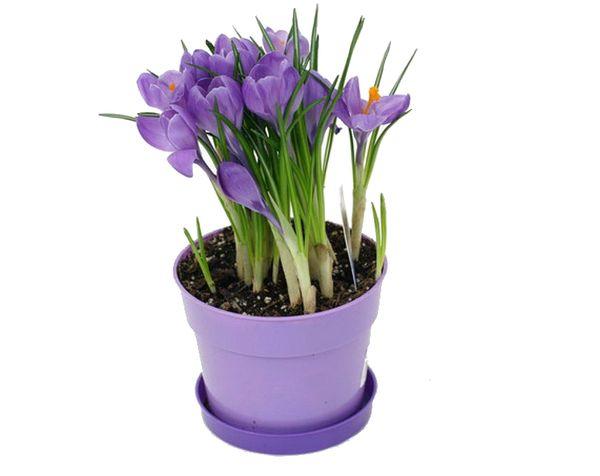
Rooting
After cooling, the potting mixture must be prepared and the prepared bulbs can be planted. They are placed at a distance of 10 centimeters from each other and from the walls of the pot.You can bury it completely, to a depth of 5-10 centimeters, or leave a "tail" on top. After that, the pot is placed in a dark and cool place and kept there for 2 months, during which the crocuses will germinate.
Planting is also acceptable, in which the bulbs are simply laid out on the ground, especially if you decide to plant a lot of saffron at once. Crocuses also root successfully, but the stems are not so straight.
Crocus care
After the planted bites have sprouted, they can be brought out into the light. Appropriate flower care will make them firm and prevent them from withering quickly. But if you are not careful, flowers fall off very quickly.
Watering and feeding
Once you've planted saffron, it doesn't need fertilizer yet. Later, choose phosphorus and potassium formulations as a good top dressing. Thanks to them, the sprouts will be strong, and the buds will form faster.

They need to be entered as follows:
- For the first time - when the first shoots appear. Take phosphorus and potassium in a 1 to 2 ratio.
- The second time - during the formation of buds, the third - after the fall of the petals. Each time in a ratio of 1 to 1.
Crocuses are harmed by frequent and abundant watering, because of it, the bulbs begin to rot. Best of all - 2-3 times a week, if you see that the ground from above has become dryish. During the flowering period, pour water not into the pot itself, but into the pan under it - this way you will definitely save the plant from excessive moisture. Remove the remaining moisture after half an hour.
Flowering stimulation
Crocuses are a plant whose flowering is easy to stimulate, for example, if you decide to please yourself and loved ones for a holiday. It is enough to calculate how long it will take for the period when the saffron is cold and taking root. This will take about 3 months.
If you want to decorate your home for the New Year, get the bulbs towards the end of August or even September. Then immediately start chilling them. Plants react to cold because it means winter is coming. If the date is March 8, refrigerate it longer.
How to care after flowering
After the crocuses have completely bloomed, you need to wait until the leaves are completely dry and fall off. Even if they feel dry, don't cut them off yourself. Remove each bulb from the ground, peel, and then store in a cool, dark place until the next flowering period. Before that, wrap it in thick, clean paper. You can also plant them in open ground.
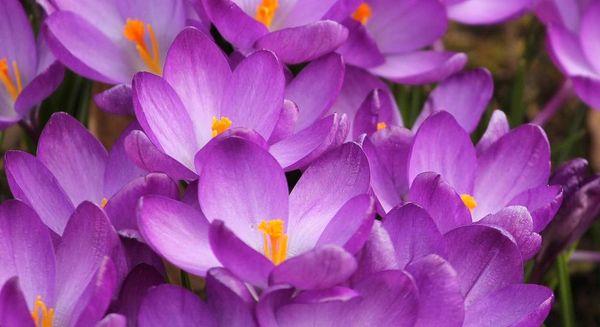
Diseases, their treatment
If crocuses are kept warm and damp, then they are affected by penicillous, sclerocial, gray rot, as well as fusarium. Gray spots on flattened, unopened flowers indicate a viral infection. It will not be possible to cure the plant - you will have to destroy it, and process the earth with potassium permanganate.
The bulbs may be damaged by fungi, to prevent this, dry the bulbs before planting and check for damage. It is important to never plant new plants next to old ones to prevent the spread of disease.
Features of distillation
When forcing, adhere to the following rules:
- Do not plant different varieties in the same container, as they have different stem heights, as well as the timing of forcing.
- Plant similar bulbs side by side. Small ones bloom later.
- Move the plant to a cold place at night (up to +3). Then it will bloom longer.
Flowering time, subject to all these requirements, is up to 3 weeks.
Possible growing problems
One of the common mistakes of flower growers is choosing the wrong plant variety. For distillation, it is preferable to choose spring varieties. Start working with them in September.
It will be difficult to achieve beautiful flowering from natural varieties, even if they are carefully looked after. Abundant watering is also very harmful to crocuses, because of this, the leaves may turn yellow.In general, crocuses work well at home if all conditions are met.
